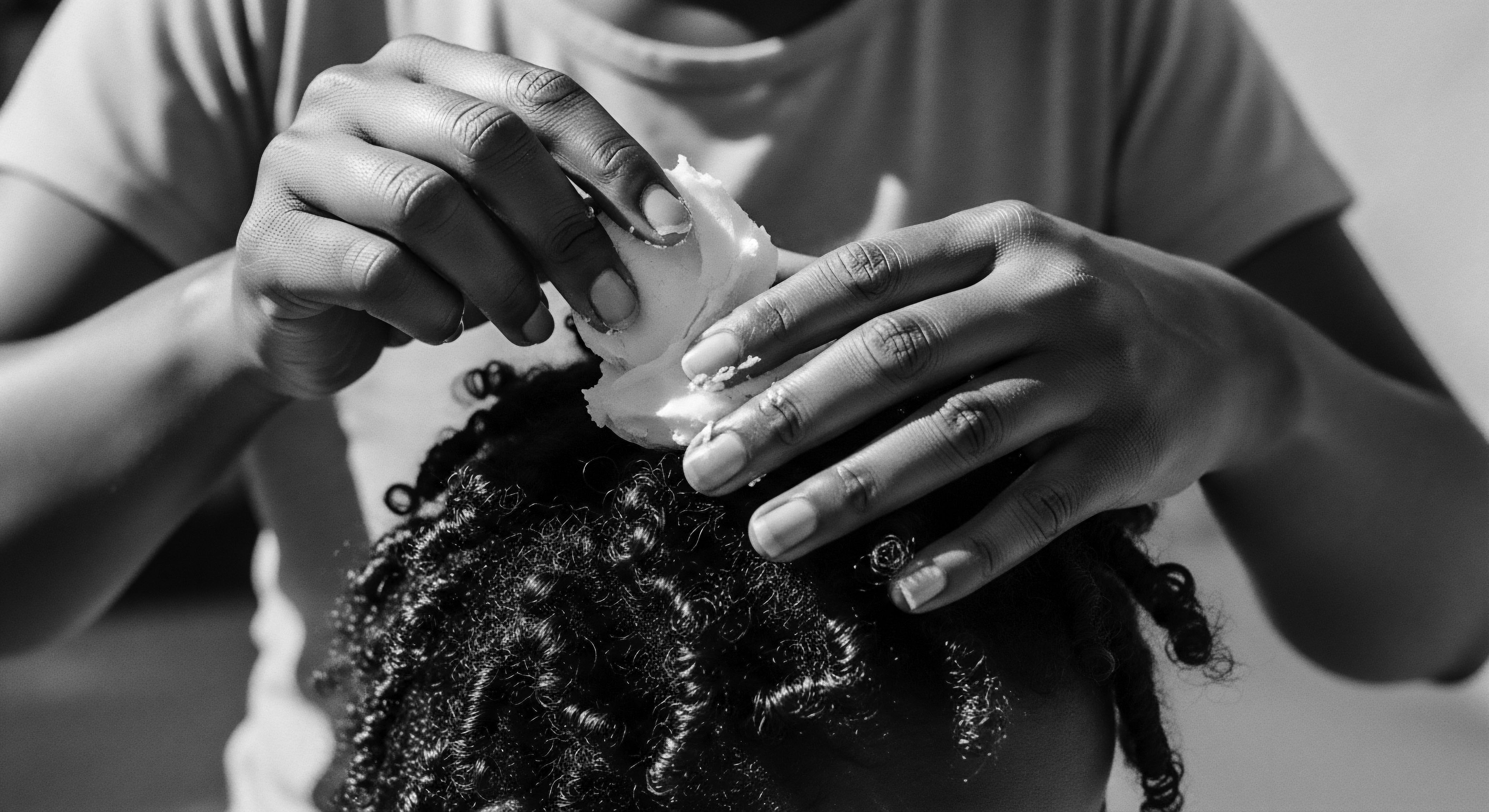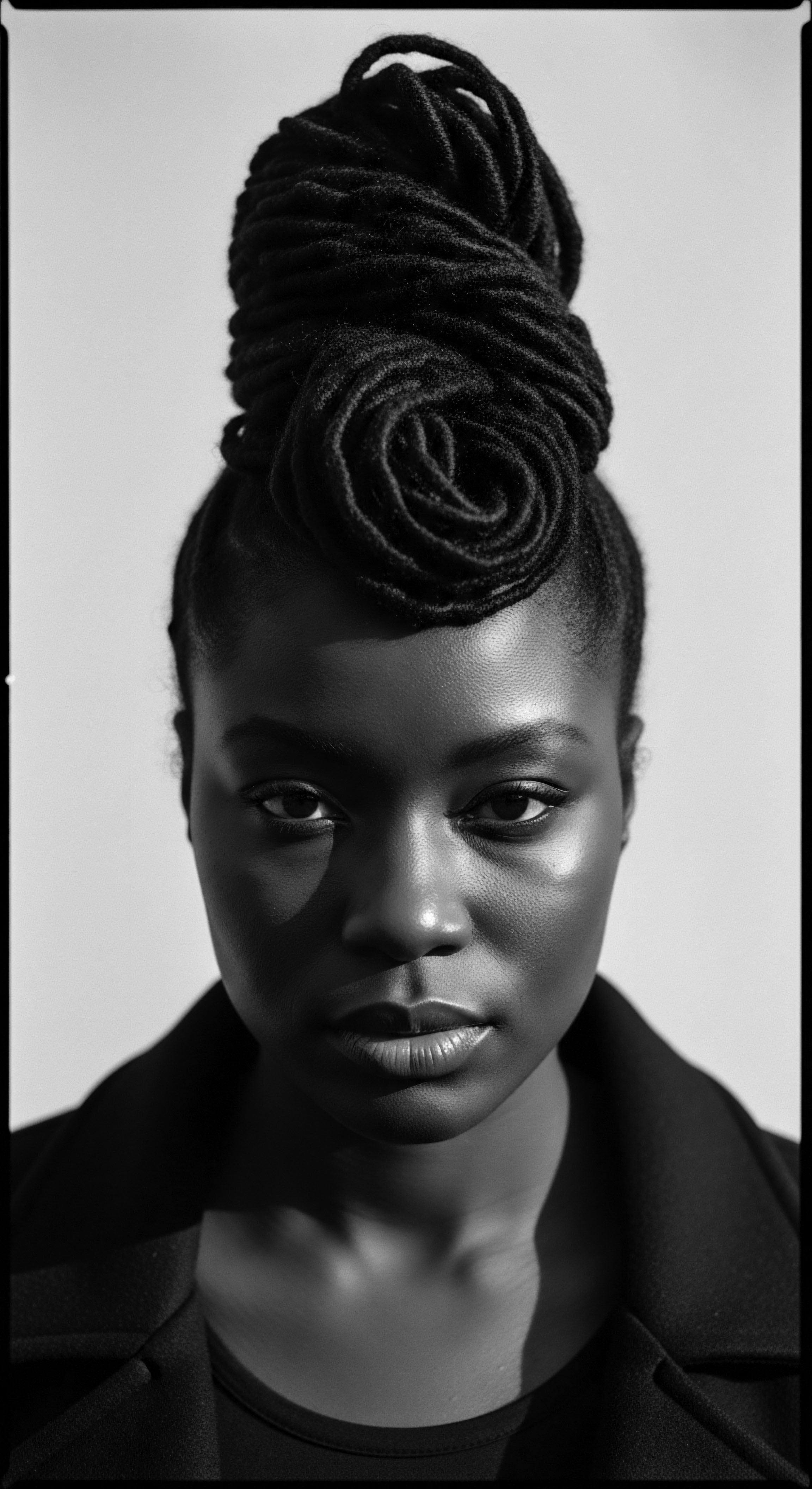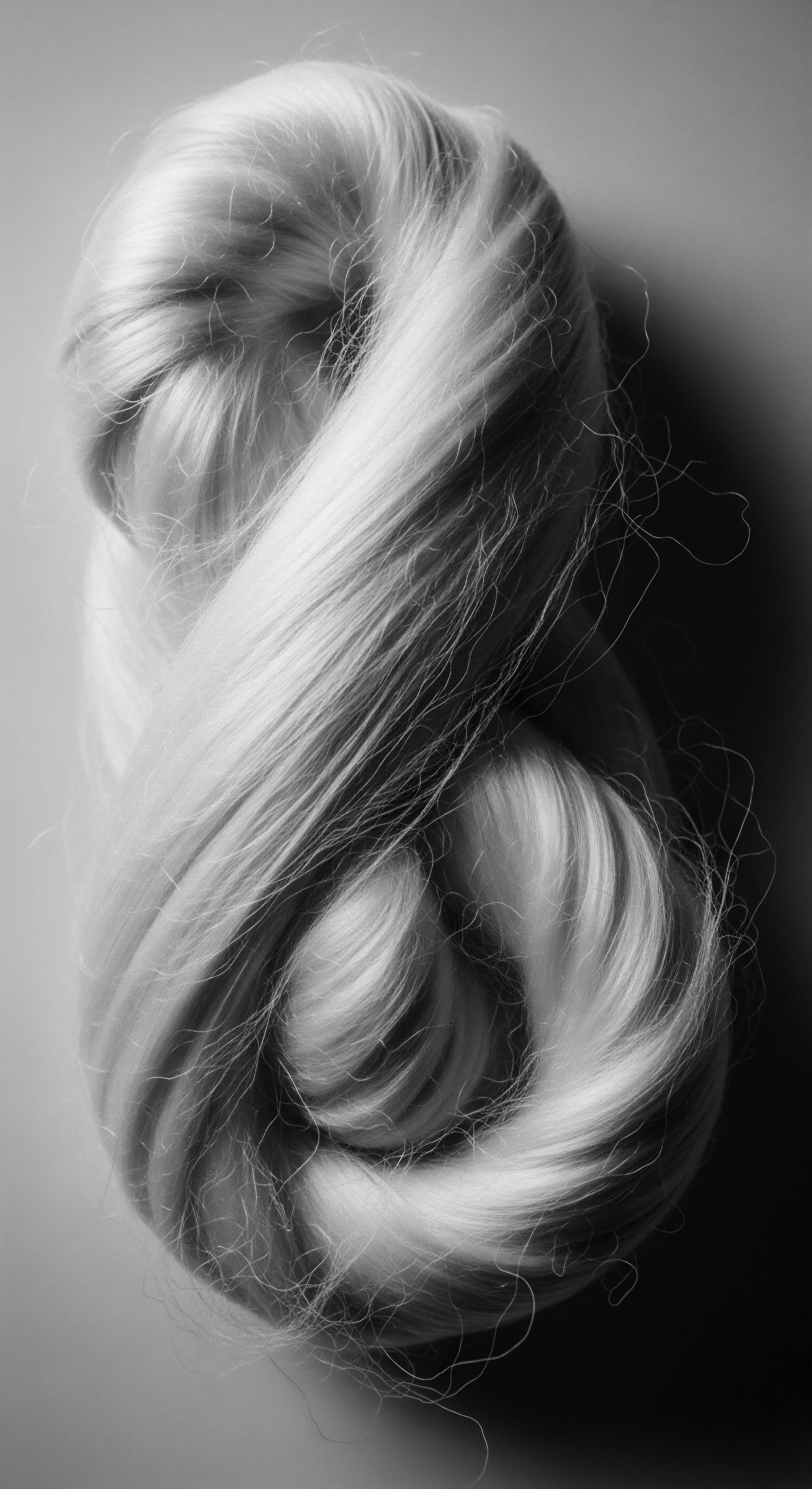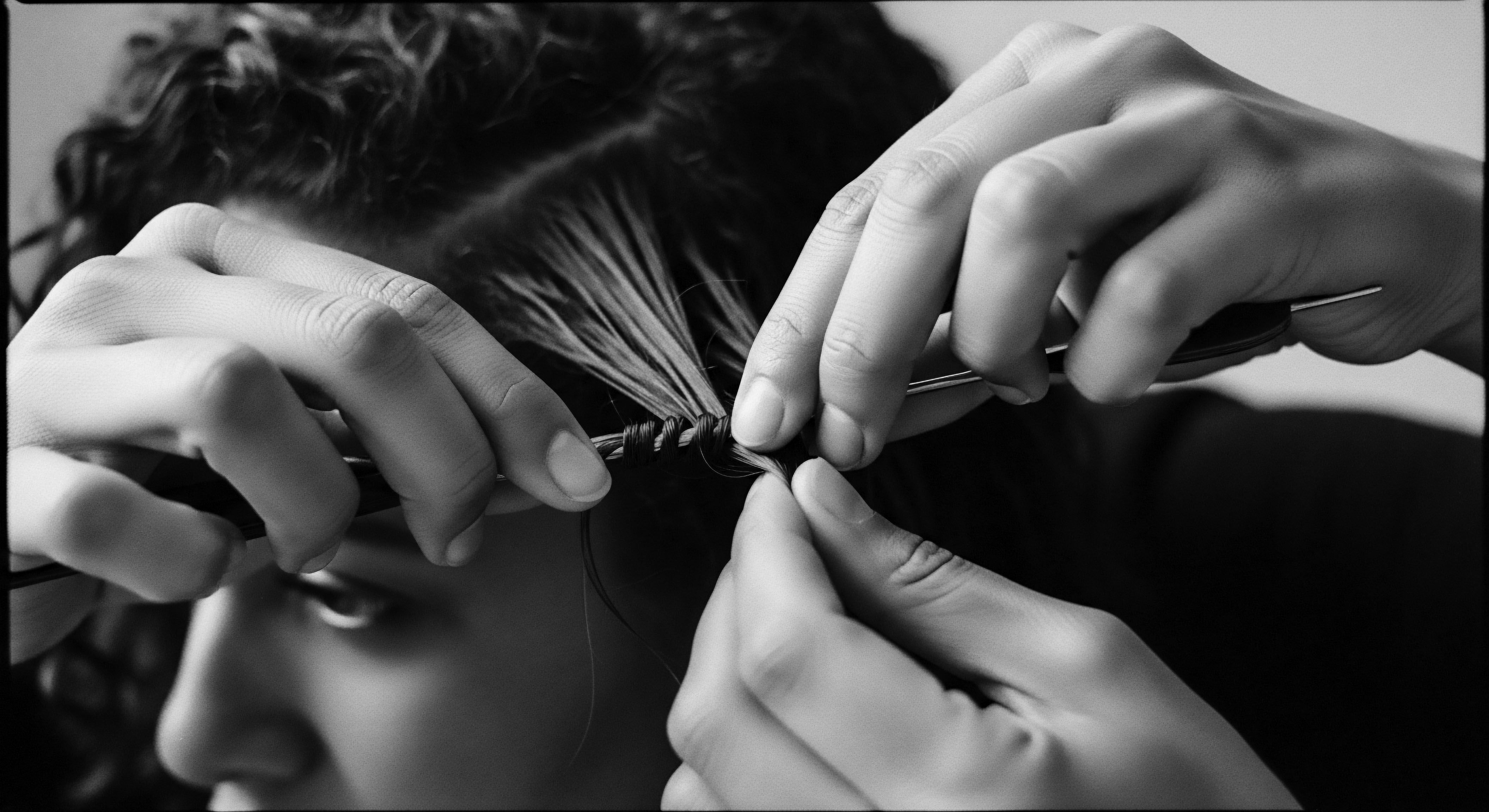
Fundamentals
The concept of Ethnobotany Hair, at its heart, represents a profound connection between the natural world and the intricate artistry of human hair care, particularly as it pertains to textured hair. It is not merely a scientific term; it is a living testament to ancestral wisdom, a deep-seated understanding of botanicals passed down through generations within communities, especially those of Black and mixed-race heritage. This initial exploration delves into the elemental meaning of Ethnobotany Hair, immediately grounding this understanding in its earliest historical and cultural contexts, illuminating how indigenous knowledge systems recognized and utilized the potent properties of plants for hair health and adornment long before modern science articulated their chemical compositions.
Ethnobotany, in its broadest sense, examines the relationship between people and plants. When applied to hair, Ethnobotany Hair becomes the precise study and practice of employing plant-derived ingredients and methods for the care, styling, and spiritual significance of hair. For individuals with textured hair, this knowledge holds a particular resonance, often serving as a direct link to their lineage and a source of resilience against colonial beauty standards.
Ancient communities across Africa, the Caribbean, and the Americas developed sophisticated systems of hair care, relying on the abundant flora of their environments. These practices were interwoven with daily life, ritual, and identity, transforming hair care from a mundane task into a sacred act of preservation and self-expression.
Ethnobotany Hair signifies the enduring wisdom of ancestral communities in utilizing the earth’s botanicals for the holistic care and cultural expression of textured hair.
In many pre-colonial African societies, hair was considered a spiritual conduit, a direct link to the divine and to one’s ancestors. The intricate styles, often achieved with the assistance of natural elements, conveyed a person’s age, marital status, social standing, and even tribal affiliation. The plants used were not chosen arbitrarily; their selection was based on centuries of observation, experimentation, and shared communal knowledge.
These botanicals offered more than just cosmetic benefits; they provided protection from environmental elements, nourishment for the scalp, and served as integral components of communal bonding rituals. This collective wisdom, refined over millennia, forms the foundational layer of Ethnobotany Hair.

Early Botanical Alliances for Textured Hair
From the arid landscapes of the Sahel to the lush rainforests of West Africa, diverse plant species were revered for their specific contributions to hair vitality. The understanding of these plants was often holistic, recognizing their benefits for the entire being, not solely for the hair. For example, shea butter, derived from the nuts of the shea tree (Vitellaria paradoxa), has been a cornerstone of West African hair care for centuries.
Its rich fatty acid profile provides deep moisture and protection, shielding textured strands from the sun and environmental stressors. This natural emolient, passed down through matriarchal lines, stands as a prime example of Ethnobotany Hair in action, a traditional practice validated by its tangible results and sustained through generations.
Another profound example arises from the women of the Bassara/Baggara Arab tribe in Chad, whose secret to long, lustrous hair lies in the Chébé powder. This powder, created from the seeds of the Chébé plant, is mixed with water to form a paste and applied to hair, often braided, to aid in length retention by filling hair shaft spaces and sealing the cuticle. This practice demonstrates a sophisticated, localized ethnobotanical application, specifically tailored to the unique needs of highly textured hair, emphasizing moisture retention and breakage reduction.
The earliest forms of Ethnobotany Hair were intrinsically linked to the environment and the resources available. The preparation of these botanical remedies often involved communal efforts, strengthening social bonds and ensuring the continuity of this specialized knowledge. These initial practices laid the groundwork for the complex hair traditions that would continue to evolve, adapt, and survive through significant historical shifts, including the transatlantic slave trade, where hair and its care became a symbol of resistance and a repository of heritage.
The following table illustrates some foundational plant-based ingredients and their historical applications within textured hair care traditions:
| Botanical Name (Common Name) Vitellaria paradoxa (Shea Tree) |
| Traditional Region of Use West Africa |
| Primary Heritage Application for Hair Deep conditioning, scalp health, sun protection. |
| Botanical Name (Common Name) Crocus sativus (Saffron) |
| Traditional Region of Use North Africa, Middle East |
| Primary Heritage Application for Hair Hair strengthening, traditional hair coloring. |
| Botanical Name (Common Name) Ricinus communis (Castor Plant) |
| Traditional Region of Use Africa, Caribbean |
| Primary Heritage Application for Hair Promoting hair growth, scalp circulation, moisture seal. |
| Botanical Name (Common Name) Lawsonia inermis (Henna) |
| Traditional Region of Use North Africa, Middle East, South Asia |
| Primary Heritage Application for Hair Hair conditioning, natural coloring, strengthening. |
| Botanical Name (Common Name) Adansonia digitata (Baobab) |
| Traditional Region of Use Southern Africa |
| Primary Heritage Application for Hair Nourishing hair masks, promoting elasticity. |
| Botanical Name (Common Name) These plant allies represent a fraction of the vast botanical knowledge passed down through generations, each contributing to the rich heritage of textured hair care. |

Intermediate
Moving beyond the foundational understanding, the intermediate meaning of Ethnobotany Hair deepens its significance by exploring how these heritage practices have been meticulously passed down and thoughtfully adapted across generations and geographies. This section defines Ethnobotany Hair with greater practical depth, focusing on its concrete applications within traditional and evolving hair care rituals for textured hair throughout the African diaspora. It emphasizes the remarkable continuity and creative adaptation of ancestral knowledge, showcasing how these botanical wisdoms remained vibrant, even amidst profound historical challenges.
Ethnobotany Hair, at this level, becomes the living legacy of cultural memory embedded within the very strands of textured hair. It speaks to the ingenuity of communities who, despite displacement and oppression, preserved and innovated their hair care traditions using available natural resources. This continuity is not static; it is a dynamic process of intergenerational learning, where the efficacy of plant-based remedies is affirmed through lived experience and communal sharing. The practical application of Ethnobotany Hair involves understanding not just the plant itself, but the traditional methods of preparation, the timing of harvest, and the specific rituals that elevate its use beyond mere topical application.
The transmission of Ethnobotany Hair practices across generations represents a profound act of cultural preservation and adaptive innovation within textured hair communities.

Adaptive Wisdom ❉ Hair Care Across the Diaspora
The transatlantic slave trade presented an unprecedented challenge to the continuity of African hair traditions. Stripped of their ancestral lands and often denied access to familiar botanicals, enslaved Africans demonstrated incredible resilience by adapting their hair care practices using new, available ingredients. This period saw the inventive use of basic home ingredients like cooking oil, animal fats, and butter, alongside the persistent desire to maintain African hair aesthetics. This adaptive spirit is a powerful aspect of Ethnobotany Hair, showcasing how the core principles of natural care persisted, even when specific ingredients changed.
One compelling historical example that powerfully illuminates Ethnobotany Hair’s connection to textured hair heritage and ancestral practices is the ingenious use of cornrows by enslaved African women. In the context of survival and resistance during the transatlantic slave trade, particularly in regions like Colombia and Suriname, cornrow patterns were not simply aesthetic choices; they served as intricate maps. Kidnapped African women, many of whom were rice farmers, braided rice seeds and other grains into their hair before being forced onto slave ships. These hidden seeds, secured within the tight, protective patterns of their hair, ensured the survival of vital crops and, by extension, their culture and sustenance in the New World.
This profound act, documented by artists like Inyang Essien whose work highlights this historical tactic, exemplifies Ethnobotany Hair not just as a beauty practice, but as a life-sustaining act of defiance and cultural transmission. The very act of braiding, often using traditional techniques, became a vessel for preserving both botanical resources and ancestral knowledge, a living archive within the hair itself. This speaks to the deep connection between hair, identity, and the practical application of ethnobotanical wisdom for survival.
- Palm Oil (Elaeis Guineensis) ❉ Widely used in West and Central Africa, palm oil provided a rich source of moisture and protection for hair, especially in regions where other oils were scarce. Its deep orange hue often imparted a subtle tint, a visual marker of its use.
- African Black Soap (Dudu-Osun) ❉ Originating from West Africa, this soap, crafted from the dry skin of local vegetation like cocoa pods, palm tree leaves, and plantains, served as a gentle yet effective cleanser for hair and scalp. It is rich in antioxidants and minerals, preserving natural oils.
- Aloe Vera (Aloe Barbadensis Miller) ❉ Though globally recognized, its use in African and Caribbean hair care traditions for soothing the scalp, promoting growth, and conditioning strands dates back centuries.

The Living Library of Practice
The knowledge of Ethnobotany Hair is not confined to ancient texts; it resides in the hands and memories of grandmothers, mothers, and aunties who continue to practice and share these traditions. It is a form of embodied knowledge, learned through observation and participation. The rituals of hair oiling, deep conditioning with plant pastes, and the creation of protective styles like braids and twists, often accompanied by storytelling and song, reinforce the cultural significance of these practices. These shared moments in communal settings, whether in family homes or specialized hair salons, serve as living classrooms where the principles of Ethnobotany Hair are perpetuated.
The resurgence of the natural hair movement globally has spurred a renewed interest in these ancestral methods. Individuals are increasingly seeking out plant-based alternatives to synthetic products, recognizing the efficacy and inherent wisdom in traditional approaches. This contemporary movement, while sometimes driven by modern aesthetics, simultaneously acknowledges and honors the deep roots of Ethnobotany Hair, validating its enduring relevance. This is a powerful testament to the resilience of cultural practices and the intrinsic value of connecting with one’s hair heritage.
The chart below provides a snapshot of how some traditional practices have adapted or found renewed purpose in contemporary textured hair care, still rooted in ethnobotanical principles:
| Traditional Practice (Historical Context) Communal Hair Oiling with Shea Butter (West Africa, pre-colonial) |
| Core Ethnobotanical Principle Nourishment, protection, community bonding. |
| Contemporary Adaptation/Relevance Modern deep conditioners and leave-ins featuring shea butter; community workshops on natural hair care. |
| Traditional Practice (Historical Context) Braiding Grains into Hair for Survival (Transatlantic Slave Trade) |
| Core Ethnobotanical Principle Resource preservation, communication, defiance. |
| Contemporary Adaptation/Relevance Protective styling for length retention and hair health; symbolic connection to ancestral resilience. |
| Traditional Practice (Historical Context) Herbal Rinses and Washes (Various African cultures) |
| Core Ethnobotanical Principle Cleansing, scalp health, strengthening. |
| Contemporary Adaptation/Relevance DIY herbal rinses (e.g. rice water, rooibos tea); commercially available herbal shampoos and co-washes. |
| Traditional Practice (Historical Context) Clay Masks for Detoxification (Morocco, West Africa) |
| Core Ethnobotanical Principle Scalp purification, mineral enrichment, curl definition. |
| Contemporary Adaptation/Relevance Rhassoul clay masks for clarifying and conditioning textured hair; mineral-rich hair treatments. |
| Traditional Practice (Historical Context) The enduring utility of these heritage practices, often validated by modern scientific understanding, underscores the timeless value of Ethnobotany Hair. |

Academic
The academic explication of Ethnobotany Hair elevates our understanding to a sophisticated, expert level, dissecting its profound meaning within the context of textured hair, Black hair, and mixed-race hair heritage, its ongoing evolution, and its scientific validation. This is not a simple definition; it is a compound, deeply insightful explication of the Ethnobotany Hair’s full significance and implications for comprehending and celebrating this living heritage. From this vantage point, Ethnobotany Hair represents a complex interplay of biological realities, historical trajectories, psychological affirmations, and societal expressions, all converging upon the unique attributes of textured hair.
Ethnobotany Hair, when examined through an academic lens, functions as a powerful heuristic for decolonizing beauty standards and reclaiming ancestral knowledge. It posits that the traditional uses of botanicals for hair care are not mere superstitions, but rather empirically derived practices, refined over generations through keen observation and iterative application. This perspective challenges Eurocentric narratives that historically devalued textured hair and its indigenous care systems.
It underscores the profound resilience of Black and mixed-race communities in maintaining, adapting, and transmitting these vital cultural practices despite systemic attempts at erasure. The meaning here extends beyond ingredient lists; it encompasses the epistemology of traditional ecological knowledge, the anthropology of beauty, and the biochemistry of natural compounds as they interact with the unique structure of coily and curly strands.
Ethnobotany Hair represents a sophisticated nexus where traditional ecological knowledge, cultural resilience, and contemporary trichology converge to illuminate the inherent wisdom of textured hair heritage.

The Interplay of Biology, History, and Identity
The very architecture of textured hair, characterized by its elliptical cross-section, numerous disulfide bonds, and propensity for dryness due to the coiling pattern, necessitates specific care. Traditional ethnobotanical practices often intuitively addressed these biological realities. For instance, the prevalence of rich oils and butters, such as shea butter and castor oil, in ancestral hair care regimens provided essential lipids and occlusive layers, minimizing moisture loss and reducing mechanical friction, which are common challenges for textured hair.
Modern trichology now validates these traditional applications, recognizing the role of fatty acids and humectants in maintaining hair integrity. (Davis-Sivasothy, 2011)
The historical trajectory of textured hair, particularly in the diaspora, cannot be separated from its ethnobotanical dimensions. The forced migration of enslaved Africans led to the loss of direct access to many indigenous botanicals. Yet, the deep-seated knowledge of hair care persisted, adapting to new environments.
This adaptability speaks to the profound cultural memory embedded within the practice of Ethnobotany Hair. As Lori Tharps, co-author of Hair Story ❉ Untangling the Roots of Black Hair in America, observes, “Your family, your tribe all had their own specific hairstyle.” This highlights how hair, and by extension its care, was a central marker of identity, status, and spiritual connection, a legacy that continued to be asserted through the creative use of available botanicals, even in the face of immense adversity.
The psychological aspect of Ethnobotany Hair is equally compelling. For generations, Black and mixed-race individuals have faced societal pressures to conform to Eurocentric beauty ideals, often leading to self-rejection of their natural hair textures. The conscious return to ethnobotanical practices, such as using ancestral plant remedies, becomes an act of self-affirmation and cultural reclamation.
It is a rejection of imposed beauty standards and a celebration of an inherited aesthetic. This choice is not merely cosmetic; it is a profound declaration of identity, a connection to a lineage of resilience and self-love.

Advanced Explanations and Scientific Validation
Contemporary research increasingly bridges the gap between traditional ethnobotanical wisdom and modern scientific understanding. A study by Nchinech et al. (2023) surveyed 100 participants with afro-textured hair on their plant usage for hair care, identifying twelve key plants, with Ricinus Communis (Castor oil) being the most cited (22%) for promoting hair growth.
While the study notes that scientific evidence directly proving castor oil’s hair growth ability is still developing, it acknowledges that ricinoleic acid, a component of castor oil, stimulates microcirculation in the scalp, a mechanism understood to support hair health. This instance showcases how scientific inquiry often provides mechanistic explanations for long-held traditional beliefs, validating the efficacy of ancestral practices through a contemporary lens.
The field of cosmetopoeia, which examines the traditional uses of plants for cosmetic purposes, is expanding to include rigorous scientific analysis of African botanicals for hair care. A review by Frazie et al. (2024) identified 68 plant species used in African hair treatment, with 30 of these having research associated with hair growth and general hair care. This research often focuses on mechanisms such as 5α-reductase inhibition and the rate of telogen to anagen phase transition, providing scientific grounding for traditional remedies aimed at addressing hair loss or promoting vitality.
The following list highlights key ethnobotanical compounds and their scientifically recognized benefits for textured hair, reflecting the academic depth of Ethnobotany Hair:
- Ricinoleic Acid (from Castor Oil) ❉ A unique fatty acid that supports scalp circulation and possesses anti-inflammatory properties, potentially aiding hair growth and reducing scalp irritation.
- Polysaccharides and Mucilage (from Aloe Vera, Okra) ❉ These complex carbohydrates provide exceptional humectant properties, drawing moisture to the hair and forming a protective, conditioning film.
- Triterpenes and Flavonoids (from Shea Butter, Hibiscus) ❉ Bioactive compounds that offer antioxidant protection, anti-inflammatory effects, and can strengthen the hair shaft, reducing breakage.
- Inositol (from Rice Water) ❉ A carbohydrate found in rice water that has been shown to repair damaged hair and protect it from future harm, enhancing strength and luster.

Ethnobotany Hair and Future Innovation
From an advanced perspective, Ethnobotany Hair is not solely about looking backward; it is a guiding principle for future innovation in hair care. Businesses and researchers are increasingly recognizing the limitations of purely synthetic formulations and turning to the rich biodiversity and traditional knowledge systems of Africa and the diaspora. This involves respectful engagement with indigenous communities, ensuring ethical sourcing, and recognizing intellectual property rights related to traditional knowledge. The long-term consequences of this academic and commercial engagement can be profound, leading to more sustainable, culturally appropriate, and effective hair care solutions for textured hair.
It offers a pathway for economic empowerment within these communities, transforming traditional practices into a source of equitable value. The academic pursuit of Ethnobotany Hair thus becomes a powerful tool for social justice, fostering a deeper appreciation for diverse knowledge systems and promoting a more inclusive future for beauty and wellness.
The insights gained from studying Ethnobotany Hair from an academic standpoint also provide a robust framework for understanding the resilience of cultural identity through hair. The ability of traditional practices to adapt and persist, often against immense pressures, speaks to their inherent value and the deep-seated human need for connection to one’s heritage. This deep understanding informs not only product development but also policy and advocacy, supporting movements like the CROWN Act, which seeks to end discrimination based on hair texture and protective hairstyles. The continuous scholarly investigation of Ethnobotany Hair reinforces its status as a dynamic, living field of study, continually revealing the profound wisdom of ancestral practices for textured hair.

Reflection on the Heritage of Ethnobotany Hair
As we conclude this exploration of Ethnobotany Hair, the profound resonance of its meaning echoes within the very Soul of a Strand. This journey, from elemental biology and ancient practices to living traditions and the shaping of future identities, reveals more than just a scientific concept; it unveils a vibrant, unbroken lineage of care, resilience, and cultural expression. Ethnobotany Hair is a testament to the ingenious spirit of humanity, particularly within Black and mixed-race communities, who have long understood that true beauty blossoms from a harmonious relationship with the earth and one’s ancestral roots.
The knowledge held within Ethnobotany Hair is a sacred trust, a whisper from generations past that reminds us of the profound wisdom embedded in the natural world. It speaks to the hands that first crushed a botanical leaf, the voices that shared remedies around communal fires, and the spirits that found solace and strength in the deliberate tending of textured coils and curls. This heritage is not a static relic of history; it is a dynamic, living force that continues to inform, inspire, and affirm the unique beauty of Black and mixed-race hair experiences today. Every application of a plant-derived oil, every careful detangling with an herbal rinse, becomes an act of honoring that deep ancestral connection.
For Roothea, Ethnobotany Hair is a cornerstone of our ‘living library,’ a celebration of the enduring power of heritage to shape our present and guide our future. It invites us to look beyond fleeting trends and reconnect with the authentic, time-honored practices that have nourished textured hair for millennia. This profound understanding compels us to recognize hair not merely as a physical attribute, but as a vibrant canvas of identity, a repository of history, and a powerful emblem of cultural pride. In embracing Ethnobotany Hair, we not only care for our strands; we tend to the very essence of our collective story, ensuring that the wisdom of the past continues to illuminate the path forward for every magnificent curl, coil, and wave.

References
- Byrd, A. D. & Tharps, L. L. (2001). Hair Story ❉ Untangling the Roots of Black Hair in America. St. Martin’s Press.
- Davis-Sivasothy, A. (2011). The Science of Black Hair ❉ A Comprehensive Guide to Textured Hair Care. Sivasothy Publishing.
- Frazie, A. Zihler, A. Kucuk, M. & Tsioumas, E. (2024). Cosmetopoeia of African Plants in Hair Treatment and Care ❉ Topical Nutrition and the Antidiabetic Connection? Diversity, 16(2), 96.
- Nchinech, N. Bouzidi, A. & Elkouali, M. (2023). Plants Use in the Care and Management of Afro-Textured Hair ❉ A Survey of 100 Participants. Scholars Journal of Applied Medical Sciences, 11(11), 1984-1988.
- Banks, I. (2000). Hair Matters ❉ Beauty, Power, and Black Women’s Consciousness. New York University Press.
- Jacobs-Huey, L. (2006). From the Kitchen to the Salon ❉ Language and the Racialization of Black Women’s Hair. Oxford University Press.
- Oforiwa, A. (2023). The History and Culture of African Natural Hair ❉ From Ancient Times to Modern Trends. AMAKA Studio.
- Cripps-Jackson, S. (2020). The Twisted Strands of Textured Hair History ❉ From Ancient Remedies to Modern Magic. colleen.
- Rosado, S. D. (2007). Nappy Hair in the Diaspora ❉ Exploring the Cultural Politics of Hair Among Women of African Descent. University of Florida.
- Essien, I. (2024). Overseeding ❉ Botany, Cultural Knowledge and Attribution. Blackwood Gallery, University of Toronto Mississauga.
